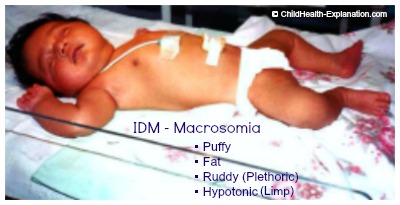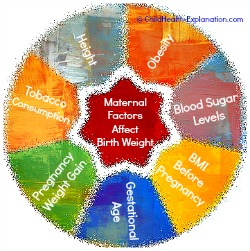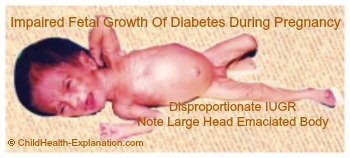Macrosomia: Large for gestational age baby
Page 1. ... Page 2. ... Page 3. .
Gestational diabetes alters fetal growth. Macrosomia, large for gestational age, signifies its fetal overgrowth effect. More maternal factors determine birth weight of IDM. IUGR, intrauterine growth retardation is attributed to microvascular disease of long standing diabetes, but mother’s addictions and health factors also contribute to impaired fetal growth.
Macrosomia is defined as a baby whose weight falls over 90th percentile for gestational age on fetal growth chart, or for babies born full term, if it is more than 4000 grams at birth.
The most common cause of babies being large for gestational age is inadequately controlled diabetes during pregnancy. Maternal glucose is easily transported through the placenta, and attains proportionately high levels in the fetus.
Fetal overgrowth is a common feature of gestational diabetes.
Studies show that even if diabetic mother’s blood sugar falls in normal range, her baby has significant risk of macrosomia. As a result, 20-50% of IDM are noted to be large for gestational age.
Risks associated with Macrosomia
- Preterm births
- Transient tachyponea of newborn
- RDS:
Respiratory distress syndrome is Inability to initiate adequate breathing at birth. It is attributed to surfactant deficiency of the immature lungs.
Newborn IDM with RDS usually require respiratory support for 2-7 days. - Cardimyopathy:
Compromised heart function. - Hypoglycaemia:
Severe with wide, unpredictable fluctuations of blood glucose values that demand diligent control - Neonatal jaundice:
Early onset and speedy rise to levels that need professional intervention
- Neonatal hypocalcemia:
Normally newborns achieve calcium homeostasis within 72 hours of birth. In IDM, parathyroid hormone response is delayed, the process of which is yet not precisely established. The delay in appropriate parathyroid hormone control is Not the influence of hypoxia experienced by IDM.
Following factors are believed to contribute to this delay -
.... 1. Low fetal parathyroid hormone levels during final phase of gestation.
.... 2. Persistent high levels of fetal Calcitonin.
.... 3. Altered Vitamin D metabolism
- Hypomagnesemia:
1. Long standing diabetes impairs mother's kidney. Consequently, large quantity of magnesium in lost in urine, and its supply to the fetus is decreased.
2. Probably also a consequence of compromised parathyroid gland as mentioned above under hypocalcemia.
3. Clinical presentation is similar to that of hypocalcemia and hypoglycemia; jitteriness, sweating, tachyponea, irritability and neonatal seizures. - Cardiovascular risk factors - cardiomyopathy, septal defects, transposition of great arteries
- Iron deficiency – may be without signs of clinical anemia.
- Neurocognitive developmental disorders:
Autism, ADHD, cerebral palsy, stroke, myopathies - Increased rates of newborn intensive care admissions
- Increased risk of birth trauma:
Large body size in proportion to head size makes macrosomic IDM more prone to birth injuries like Erb’s palsy, shoulder dystocia and brachial plexus trauma - Predisposition to metabolic syndrome during tween and teen years
Liked what you read just now? Pay it forward!
Have a Question? Ask the Expert and Get the Answer for Free
Factors that influence IDM's birth weight
The most important causes of large for gestational age baby are:
- Maternal obesity singularly has a great influence on development of fetal macrosomia
- Mother's BMI before pregnancy
- Maternal height
- Speed of rise in mother's weight during pregnancy
- Mother's blood sugar levels
- Gestational age of the baby at birth: Large for gestational age IDM are often born preterm.
Impaired fetal growth
1 in 5 cases of diabetes during pregnancy suffers impaired fetal growth
1. IDM born preterm
IDM born preterm are usually large for gestational age, but can yet be really low birth weight attributed to the severity of the prematurity.
2. IDM - IUGR: Intrauterine growth retardation
- Microvascular disease attributed to long standing diabetes in the mother.
- Multiple gestation: Twins, triplets...
- Intrauterine infections
- Tobacco consumption in any form
- Alcohol consumption during pregnancy
- Mother's health: Chronic diseases like kidney disorders, high blood pressure, heart disease and so on.
Health risks for IDM with intrauterine growth retardation
IDM with intrauterine growth retardation, like macrosomia, suffer all the ill effects of hyperglycemia and hyperinsulinemia.
Additional risks are:
- Predisposed to severe infections due to poor development of body defenses,
- Prone to severe perinatal hypoxia.
- Inability to tolerate the stress of birth process.
- Risk of severe hypothermia, because the temperature control mechanism remains immature.
Both macrosomia and intrauterine growth retardation IDM are challenge for clinical management and outcome is guarded.
Have Questions? Click here and Post them - It's Free
Page 1. ... Page 2. ... Page 3. .
Related pages of interest are indexed in the right column
Liked what you read just now? Pay it forward!












New! Comments
Have your say about what you just read! Leave me a comment in the box below.